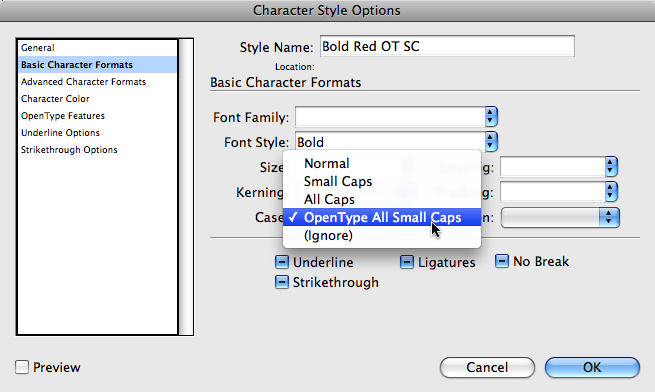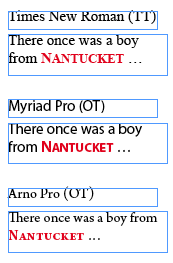Small Caps vs. OpenType All Small Caps
If you think the OpenType All Small Caps option is the best choice for styles that use OpenType fonts, think again.

The Basic Character pane of the Paragraph Styles and Character Styles dialog boxes has a place where you can choose the Case of the type: Normal, Small Caps, All Caps, and OpenType All Small Caps.
If you want the style to use small caps, and you’ve specced an OpenType font, you might be inclined to choose OpenType All Small Caps, right? Thinking that tells InDesign to pull from the specially-cut glyphs for OpenType small caps, instead of crudely scaling down the capitals in the font?
Think again. In most cases, you’ll want to choose the plain old Small Caps choice, regardless of the format (T1, TT, OT) of the typeface you’re using.
Two reasons: First, when it comes to OpenType fonts, it makes no difference to InDesign if you choose Small Caps or OpenType All Small Caps. If the OT face has the special small cap glyphs built-in, InDesign will use those glyphs, period. Second, by choosing OpenType All Small Caps, you risk losing the small caps case change should you ever decide to tweak the style by changing its typeface.
In other words, if you want a style to always be small caps, regardless of the typeface, use the Small Caps option.
Let me show you how using OT All Small Caps is usually not the right choice. I created a character style that makes the type bold and red, and chose the OT All Small Caps option.
I applied this character style to the word “Nantucket” (set in u/l) within the same instance of text in three different typefaces: Times New Roman (TrueType), Myriad Pro (OpenType), and Arno Pro (OpenType).
Note how the case didn’t change in the Myriad Pro example, even though it’s an OpenType font. Why? Because MyriadPro doesn’t have Small Caps glyphs built into it. Arno Pro changed successfully, because it does. Also note in the Arno Pro example that the cap N changed to a small cap – the option is called ALL Small Caps for a reason. Pesonally, it’s rare that I’d ever want capitals changed to small caps in the work I do. (Sure, in some instances I might want exactly that … but rarely.)
Now, if I change the character style’s Case setting to Small Caps (instead of OpenType All Small Caps), here’s what I get:
All the examples changed to Small Caps, and the cap N is retained even in the Arno Pro example. InDesign had to use scaling to create the small caps in the Times New Roman and Myriad Pro instances, but for Arno Pro, it used the specially-designed small cap glyphs as before.
(To make it easier to tell that Arno Pro isn’t being scaled, before I took the screen shot I bumped up the small caps scaling from 70% to 85% in Preferences > Advanced Type. For the Times and Myriad example, the small caps are almost as tall as the capital N; but Arno Pro’s small caps are the same size as in the previous example.)
So, if choosing Small Caps works for any typeface, why would you ever use OpenType All Small Caps?
I’m not sure. There’s gotta be a reason they included it, though! If you have an answer, I’d love to know … please comment.
In the meantime, I’d recommend you stick with choosing the plain old Small Caps option when choosing a case for a style. It’s a flexible solution that works with any typeface, and is intelligent enough to use those beautiful OT small caps glyphs whenever it can find them.
This article was last modified on December 19, 2021
This article was first published on November 2, 2008








